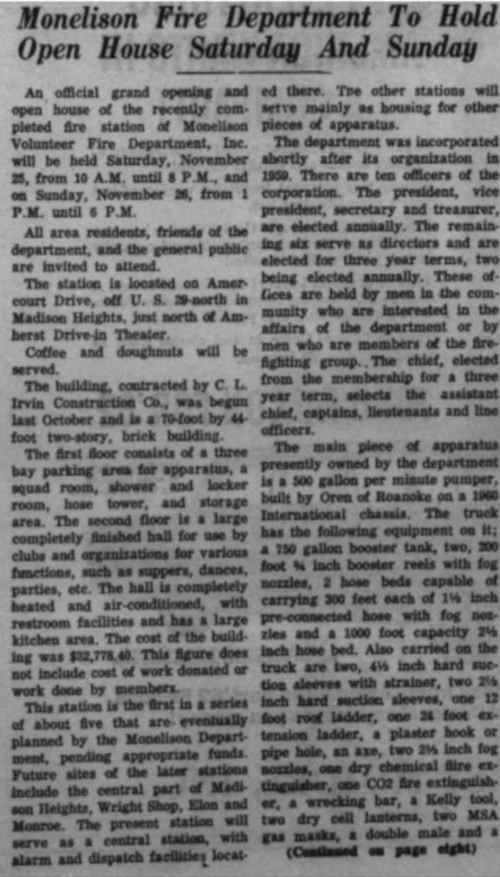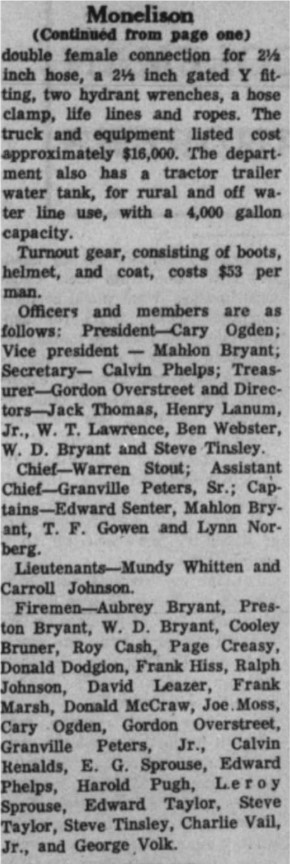| Upcoming Events |
| There are currently no events |
| View All Events |
| 2025 Incidents | |
| Jan | 78 |
| Feb | 70 |
| Mar | 80 |
| Apr | 54 |
| May | 0 |
| Jun | 0 |
| Jul | 0 |
| Aug | 0 |
| Sep | 0 |
| Oct | 0 |
| Nov | 0 |
| Dec | 0 |
| Total | 282 |
| Previous Year Incidents | |
| 2024 | 680 |
| 2023 | 726 |
| 2022 | 634 |
| 2021 | 641 |
| 2020 | 567 |
| Web Counters | ||||||
|
|
Monelison Volunteer Fire Department Our History Our Stations and Apparatus
Each station is equipped with a range of apparatus, including engines, tankers, brush trucks, and rescue units, ensuring rapid and effective responses to emergencies across the southern county. Our Commitment Join Us To learn more or apply, please contact us:
Stay connected with us for updates and safety tips. Together, we can continue to protect and serve the Amherst County community.
Hazardous Materials Response & EducationResponding to hazardous materials (hazmat) incidents requires precision, training, and a thorough understanding of the materials involved. Hazmat situations are unique, representing low-frequency but high-consequence events that often demand coordination between multiple agencies. Firefighters must be able to quickly identify risks, assess threats, and execute mitigation strategies to protect lives, property, and the environment. Mastering hazmat response is akin to learning the diagnostic skills of emergency medical services (EMS)—focused, detailed, and essential. While hazardous substances may seem complex, understanding their chemistry and behavior enables firefighters to approach these scenarios with confidence and competence. Forestry FirefightingWildland firefighting presents unique challenges, requiring personnel to work long hours under extreme conditions. Firefighters may face intense heat, unpredictable weather, and rugged terrain as they combat wildfires. These brave individuals use specialized techniques and equipment to suppress fires, prevent their spread, and protect both natural and human resources. Their dedication ensures that vulnerable ecosystems and communities remain safeguarded. Fire SuppressionFire suppression involves the containment and extinguishment of fires in buildings, vehicles, forests, and other environments. Firefighters employ advanced training and tools—including water, foam, chemical agents, and fire behavior analysis—to effectively neutralize fire threats. This work not only saves lives and property but also helps minimize environmental impacts. Fire suppression is a cornerstone of fire department operations, showcasing the skill and bravery of those who serve. Swift Water & Flood Search and Rescue (SAR)Swift water and flood rescues require specialized training and equipment due to the dangerous and unpredictable nature of moving water. These operations are a subset of technical rescue, involving rapid currents, debris, and other hazards. Firefighters trained in this discipline use advanced techniques, ropes, and mechanical systems to safely extract individuals from life-threatening situations. Their expertise ensures the highest level of safety during these critical incidents. Emergency Medical ResponseFire departments are uniquely positioned to provide emergency medical response services, often arriving as the first line of aid in life-threatening situations. Through rigorous training, teamwork, and dedication, firefighters deliver exceptional care to those in need. Whether responding to medical emergencies, trauma incidents, or natural disasters, fire departments are prepared to act at a moment’s notice, ensuring the safety and well-being of their communities. Fire Safety & Prevention TrainingThe goal of fire safety and prevention is to empower the community with knowledge and strategies to reduce the risk of fires. By educating the public on fire hazards, prevention techniques, and survival skills, fire departments can significantly decrease the likelihood of fires and improve overall safety. Prevention programs, community outreach, and hands-on training are vital to fostering a safer environment for everyone. Vehicle Extrication & RescueVehicle extrication is a critical skill that involves safely removing individuals trapped in vehicles following motor vehicle accidents (MVAs). When conventional methods are not feasible, firefighters use specialized tools like hydraulic cutters, spreaders, and stabilizing equipment to carefully extract victims. The focus is always on minimizing further injury and ensuring rapid medical attention. |







